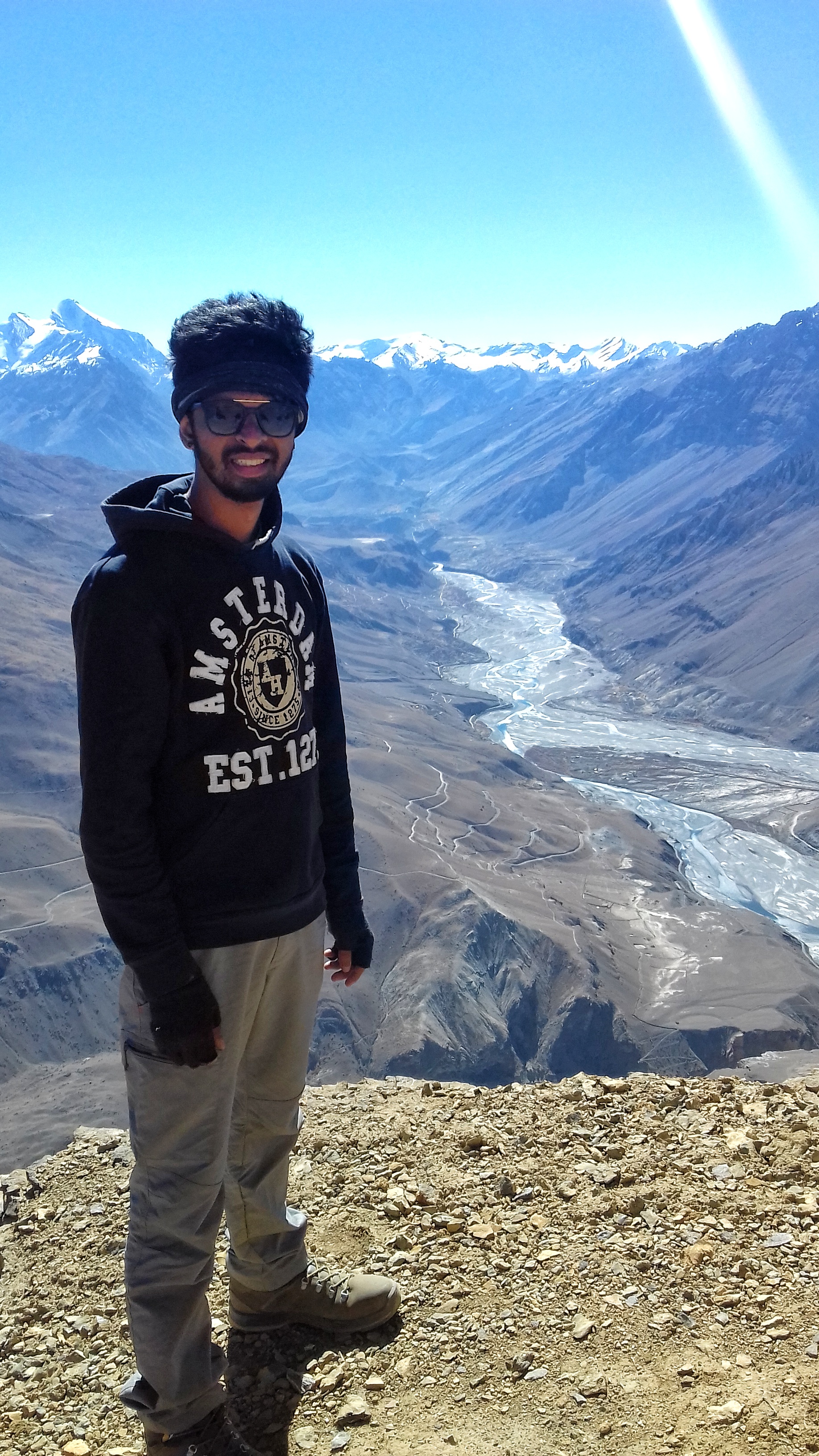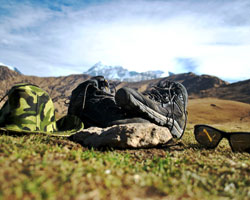Nepal Treks - Gears and Equipment
Here is a detailed list of gears and equipment specific to Nepal Treks such as Annapurna Base Camp (ABC) Trek, Everest Base Camp (EBC) Trek and Khopra Ridge Trek.
This extensive list of items will help you pack accordingly and prepare well for your treks in Nepal.
A) Clothing
1. Base layer: The best base layers sit tightly to the skin (reducing airflow) and consist of high wicking material to allow moisture to escape.
2. Fleece Jacket: The second layer, or insulation layer, sits over your base layer and is best made from fleece or micro-fleece material.
3. Insulated Jacket: The third layer, or outer core layer, consists of a warm and waterproof jacket and trousers which you will use on the upper reaches of your Everest Base Camp trek.
4. Down jacket: It’s light and warm. At least, 700-fill goose down insulation for lightweight warmth. It gets very cold at night and in the early morning.
5. Rain Gear: You may face rain on the lower reaches of the trek, particularly if you are planning to trek near June-September. You should bring a waterproof jacket and waterproof outer trousers (Prefer Gore-Tex material).
6. Trekking Shirts/ T-shirts: 3-6 trekking shirts (short and long sleeve) which you will wear on most trekking days. This should be lightweight & breathable shirts.
7. Trekking Pants: 3 pairs of hiking pants, one convertible (it can get hot in the afternoon).
8. Trouser/Pants: 1 jean and 1 Cotton pants for while you are roaming in Kathmandu, and 1 Pant (either fleece or other heavy sweat pants) to wear during the evening downtime.
9. Underwear tops: At least 3 underwear tops to wear as a base layer.
10. Underwear bottoms: At least 6 underwear bottoms as a base layer.
11. Gloves: Insulated gloves to keep your hands warm on the cold morning trek and liner gloves for cool temper in the evening.
12. Hats: Warm one for the morning and baseball cap or sun hat for the afternoon.
13. Head Band: It starts to get really cold in the late afternoon / early evening; particularly as you get closer to Everest Base Camp. A warm fleece beanie or fleece headband is a must.
14. Buff or Balaclava or Neckband: A buff helps keep your neck and face protected and prevents particulates from entering your throat when you breathe.
15. Trekking Towels: A small to medium-sized trekking towel is useful for drying off after a quick clean which should provide good, quick-drying trekking towels.
16. Sack /Plastic bags: 2 plastic bags or sacks in which you can store your dirty or wet clothes.
B) Footwear
1. Hiking boots: The key characteristics to look for in a boot: make sure it is light-to-mid-weight (full leather boots tend to be too heavy, uppers of the boot can be made of leather or leather condura), has high tops for ankle support, rubber soles with deep lugs for good traction, and a lacing system that incorporates d-rings or speed hooks for quick lacing and further ankle support.
2. Hiking shoe or Sneaker: A basic pair of lightweight shoes or sneakers that you can wear in the teahouses after a long day of trekking or as an extra, or use in Kathmandu.
3. Woolen Socks: 3 pairs of woolen socks as they allow the foot to breathe and can thus be reused multiple times before they need a hand-wash.).
4. Light Socks: 3 pair of light Normal socks for normal use in normal temperature atmosphere.
5. Gaiters: They are used to prevent water, mud, dust and small stones from getting into your boot. It should be made from waterproof material and extend up from your foot to your calve. (Optional)
Note: Gaiters are mainly required in Annapurna Region only. For Everest region normal high anklet Shoes are fine. Gaiters are available on rent also.
C) Gears
1. Day backpack: you should bring with you a 25-35 L backpack. You will want to have a lightweight daypack to carry your personal essentials on your daily trekking route.
2. Rucksack: you should bring with you an 80-90L rucksack bag. The best bags are made of waterproof laminate material, have strong and sturdy zippers and easy to access hand and shoulder straps. Porter or yak will be carrying your rucksack and make sure the weight does not exceed 10 kgs.
3. Trekking Poles: These will provide you with balance and support Good trekking poles reduce the impact on your knees and other leg joints by up to 20%. This is particularly beneficial when descending as the load on your joints increases exponentially. (Optional) Trekking poles are available on Rent also.
4. Sleeping bags: You will need sleeping bags only if it is too cold and the temperatures plummet down. Pair it with the blankets provided to you in homestays and tea houses that will help you keep warm. Ideally, your sleeping bag should have a mummy-shape with an insulated hood and draw chord so that it fits the contours of your body. A two-way zipper for better insulation is also great. Make sure that it is a four-season bag and has a rating of at least -10°C. Sleeping bags are available on rent also.
5. Small lock: Bring a small lock for your duffle bag or Rucksack.
D) Accessories
1. Headlamp: You will not be trekking at night, but might need a headlamp for the early morning trek to Kala Patther. Also many of the lodges are poorly lit. Your headlamp can be used to go to the toilet at night or if you want to read after dark.
2. Water Bottle or Hydration Bladder: You can either carry your water in a standard 2L water bottle –or if your daypack includes space for a hydration bladder (the Osprey Talons do) then the 2L Hydration Bladder is a great product. Make sure it should hold Hot or Coldwater.
3. Cameras, batteries, and memory cards: you want to make sure your camera is light but still able to capture high-quality images. Bring extra batteries. 64 GB of memory card should be sufficient. (Optional).
4. Waterproof Ziplock Bags: To safely store important/valuable items like your passport, money and electrical equipment.
5. Sunglasses: The UV intensity in the Himalayas is relatively high due to the altitude and snow glare. Please ensure you bring a good pair of 100% UV protection sunglasses (minimum of 80% light reduction).
6. Book / Kindle/ Tablet: There is a lot of downtime in the evening on the trek. For entertainment, you might want some reading material. Don’t carry heavy or big sizes book. (Optional).
7. Portable battery charger: For electronic devices like your mobile phone, an e-Reader or camera/GoPro, then you will want to be sure that you can recharge these devices. Having a Portable Battery charger helps a lot (Optional).
E) Personal & Medicals
1. Pain reliever: Paracetamol for headaches (which are a common altitude sickness symptom) and Imodium for diarrhea (another common problem as food preparation areas can be a little unhygienic.
2. Personal first aid kit: Carry your personal medication which is prescribed to you.
3. Band-Aids: Untreated blisters could make your trek very difficult; fabrics are best.
4. Necessary Cosmetics: Sunblock (35+SPF), Face wash, Hand wipes, Cold cream, Lip balm, etc.
5. Snacks and goodies: Bars, energy bars, chocolate, nuts, and powdered drink mix are all great to sweeten the trail and to give you a boost of much-needed energy on the trail.
6. Toiletries: All your basic toiletries, including toothbrush and toothpaste, 2 Rolls of toilet paper






